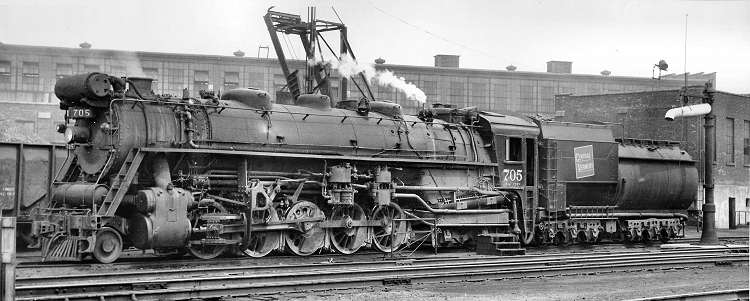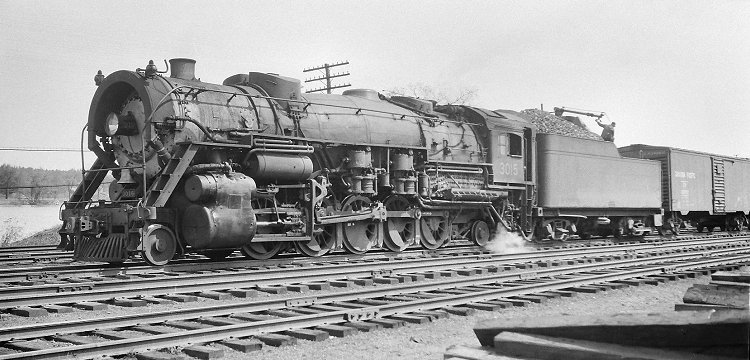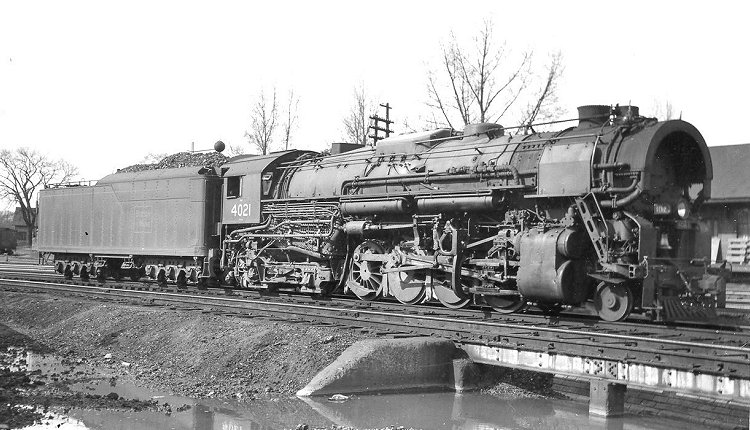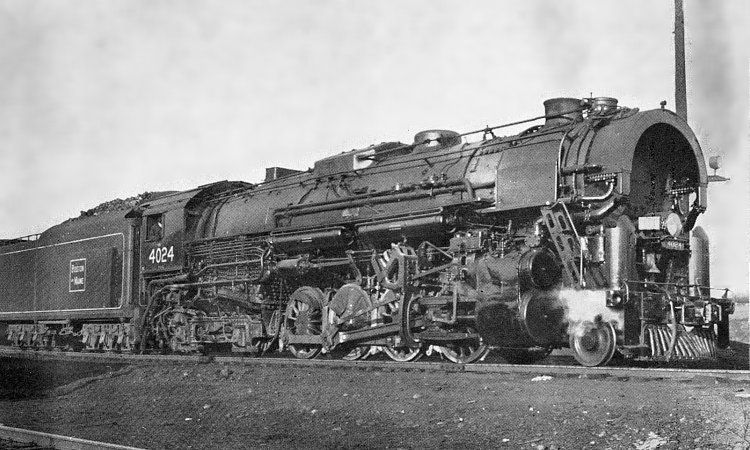Apparently Overland Model made and sold a brass HO model of #5315. Seems kind of tasteless if you ask me.


Apparently Overland Model made and sold a brass HO model of #5315. Seems kind of tasteless if you ask me.


I bought another book off the IRM used book store last night. The Pennsylvania Railroad: 1940s-1950s by Don Ball Jr. I'm a big fan of the PRR, this book contains some really rare shots from what I've heard (like N&W #610 testing on the PRR) and Don Ball Jr is a terrific writer. Not quite on par with David Page Morgan, but up there.

I assume this book was his penance for his years of ignoring and deriding the PRR. In America's Colorful Railroads he said that he and his friends paid little attention to the PRR, disregarding it as a railroad that operated grimy engines and "hauled ties in their dining cars". Only in later years, when other surrounding railroads dieselized and the PRR was the last man standing and they went to watch the PRR as a last resort did they realize what they missed.
Central Vermont 2-10-4 Texas #706 drifts into Brattleboro, VT with a freight due for New London, CT. The big Alco product will be swapped out for one of CV's older Consolidations as weight restrictions prevented the Texas from crossing several bridges on the line to New London.

Central Vermont's 2-10-4s were always an oddity. Were they the little engine that could, or the big engine that couldn't? The Central Vermont traced it's lineage back to the 1850s as the Vermont Central Railroad, undergoing a series of mergers, buyouts, bankruptcies and renamings before becoming the CV. In 1896 it had gone into receivership and in 1898, it had been purchased by Grand Trunk Railroad, and then post-WWI the Grand Trunk had been merged with Canadian Northern, the National Transcontinental, and the Intercolonial by the Canadian Government to create Canadian National in order to save a collapsing railroad industry (the government had forced the railroads to operate at a loss during WWI). While Grand Trunk almost immediately took on the appearance of Canadian National's corporate look (Elesco feedwater hung over the smokebox, Vanderbilt tender, angled rectangular red herald on the tender), the Central Vermont retained its own identity. A quaint, backwoods little line, it operated a variety of lightweight and toy-like motive power at the time.
This included pre-1900 Ten-Wheelers, some of which were built in 1892 by the Rhode Island Locomotive Works

A total of nine 4-6-2s built by Baldwin in 1910 and 1912. These would later receive superheating, Elesco feedwater heaters, headlights relocated to above the smokebox door centerline and smoke deflectors that gave them an odd, almost European look.



And multiple small classes of Consolidations, the largest power on the CV, but light by every other railroad's standards. Most unusual were the M-3a class, which had "clear vision" tenders and the rarely-seen horseshoe-shaped Coffin external feedwater heaters.


But when a flood in 1927 wiped out a large part of the Central Vermont's tracks, Canadian National sent down 5000 workers and poured $3 million dollars into the Central Vermont. At that point in time, the CV slowly started to conform to the Canadian National's corporate image. On went Elesco feedwater heaters, the numers were moved to the cab and an angled Central Vermont herald was applied to the tender, and the headlights were moved down to the smokebox door.
A good example of this was CV Pacific #230. Compare her builders photo from 1910 to the 1935 shot at St. Albans.


In addition to the new look of the CV, newer, larger engines began to arrive. The four U-1-a class Mountains, which were identical to U-1s used on Grand Trunk Western and Canadian National, almost went unnoticed. The 4-8-2 wasn't particularly out of the ordinary, the Boston & Maine, the New Haven, the Bangor & Aroostook, the Boston & Albany and even the tiny Rutland all operated Mountains (or Mohawks, in the B&A's case). The CV's were pretty handsome though, with clean lines, a large smokebox door, no feedwater heater and smoke deflectors that appeared inspired by German railroads. The outside-journal pilot truck was also very unusual.

What followed though, in 1928, was surprise. Ten 2-10-4s, built by Alco. The Canadian National influence was strong, with a Vanderbilt tender, a huge Elesco feedwater heater hanging over the smokebox, all-weather cab, air reservoir tucked under the boiler on the pilot and 60" drivers.
These were tough-looking workhorses, and the largest steam engines on all of Canadian National's lines, as well as all of New England. Boston & Albany had owned a group of USRA Light 2-10-2s, but they had been too tough on rails and too slow for B&A's fast freight focus, so New York Central had sent them to the Midwest on the Big Four Line after just a few years before selling them to Canadian National in '28. New Haven also owned a pretty successful batch of Santa Fes, the L-1 class. The B&A Class Z 2-10-2s had 57" drivers, a 75.96' total wheelbase, a total weight of 540,300lbs and generated 69,575lbs of tractive effort. A New Haven L-1 Santa Fe had 63" drivers, a 74.75' total wheelbase, a total weight of 562,000lbs and exerted 77,714lbs of tractive effort. A Central Vermont T-3a rolled on 60" drivers, had an 82.18' wheelbase, weighed 688,600lbs and beat the rails with 82,620lbs of tractive effort.

Interestingly, despite being the beast of the northeast, the Central Vermont T-3a was small for a Texas type. The smallest, lightest and shortest-drivered in fact. Parked next to a Santa Fe 5011-class, with it's even million pounds, 98.64' wheelbase, 74" drivers and 100,000+lbs of tractive effort, a CV 700-series looked almost diminuitive. Same with the Texas & Pacific's 600-series or the C&O T-1/PRR J1. They were still big for the CV though, being restricted on where they could travel on the system, due to rail and bridge weight requirements, as well as not fitting on all of Central Vermont's turntables and roundhouses.

The sanders are on, as T-3a class leader, #700, gets a freight moving north out of Brattleboro. Brattleboro was the farthest south they could run.

The #706 gets turned on the wye at Brattleboro. The big Texas-types didn't fit on the turntable at Brattleboro and so had to be turned on the wye instead.

#703 going for a swim at Northfield in '36. The #703 was retrieved, repaired and returned to operation.

#709 at the on the ash pit at the Boston & Maine's engine terminal at Westboro, NH. Since The B&M engine facility was across the river from the Central Vermont's White River Junction yard, I have to guess that the CV's ash pit either wasn't long enough or strong enough to support the T-3a.

While hard-workers, the 700s were hard on tracks, thanks to those short drive wheels (harder to counterbalance). They were also slow 30mph pounders, which wasn't a huge issue due to CV's short haul distances and numerous curves and grades that naturally restricted speeds. But this did run contrary to the concept of the Texas-type. The Texas was not an outgrowth of the 2-10-2 Santa Fe (like the Hudson was the Pacific, or the Berkshire was the Mikado) but was instead the evolutionary step-up from the Berkshire. When manufacturers realized that a large firebox supported by a 2-axle trailing truck could easily keep enough pressure to operate a 4-axle locomotive at speed continuously, they took a Berkshire and tagged a 5th set of drive wheels on an the even more powerful Texas fast-freight locomotive was born. But the CV T-3a was a slow drag freight engine, more like a 2-10-2 Santa Fe. The Texas type was chosen by CN/CV simply because the additional trailing axle helped spread the weight out more to operate on the CV's light rails.

In reply to NickD :
White River Junction is still pretty active (I think there's a roundhouse still standing on the east side, but I haven't checked it out), and there's a decent-sized yard in Brattleboro. The stretch of track in the first shot you posted is still there and active, but down to a single line and quite overgrown.

Boston & Maine #494 is housed at White River Junction.

In reply to 02Pilot :
Researching the White River Junction roundhouse, the original Central Vermont structure burned in 2008. New England Central Railroad built a near identical building on the spot to use as their headquarters.
Its too bad that Central Vermont didn't preserve any of the Texas types. Or many other examples of steam locomotives. Only a single CV locomotive, Ten Wheeler #220, is preserved. Its really strange because parent companies Canadian National annd Grand Trunk preserved double-digit numbers of steam locomotives. One of their Consolidations or Pacifics would have been a nice save.
Another unusual spot that the 2-10-4 configuration popped up in was on the Chicago Great Western. The Corn Belt Route had operated a fleet of rather unremarkable steam locomotives for most of it's existence, with a fleet largely consisting of Mikados and Consolidations of rather average size. There were ten 2-6-6-2s in the '20s but they were sold to the Clinchfield almost immediately, and six Santa Fes that were built in 1916 but retired in the '30s. The only really noteworthy locomotives that they ran were a collection of unusual superheated, Vauclain compound 2-6-2 Prairies.
So it was a bit of a surprise when in 1929, 2-10-4s began arriving on the property, 18 built by Lima and 18 built by Baldwin. They were all coal-burning engines, with Baker valve gear, 63" driving wheels, 29"x32" cylinders and weighed 767,000lbs. But between batches there were variances. Class T-1, #850-#864 were built by Lima in 1930 with a Franklin C-23 trailing-truck boost worth 13,300lbs of tractive effort when cut in. Class T-2, #865-#873 were built by Baldwin in 1930 and used Worthington feedwater heaters. Class T-3, #874-#879 were built by Baldwin and identical to the T-2s othern than using Bethlehem tender truck booster engine and being built in 1931. And another batch of T-1s, #880-#882 and built by Lima were delivered in 1931 with Coffin internal feedwater heaters.
They were powerful machines, but not exactly handsome. Most noteworthy were an overly large headlight, a small smokebox door and a large angular sand-dome that would make even an Illinois Central fan cringe.

Closing in the pilot with a sheetmetal cover like #879 did not help their appearances either

There were also the logistical issues that the CV had when operating their 2-10-4s. The 2-10-4s drastically improved freight train speed and tonnage for the CGW but they could not enter Kansas City, because the Missouri River bridge at East Leavenworth could not support the 2-10-4's. In fact, the bridge could not support the CGW's USRA Light Mikados either. The CGW had to use an older, lighter group of Mikados across the bridge and on the 30 mile run to KC. Also, shortly after taking delivery, one of the big newcomers was placed on a siding and, while standing still, rolled over on it's side due to the rail being unable to support it. There were places where, opposite the normal operating procedure, passenger trains went 'in the hole' when meeting freights because the light siding rail could not cope with the 2-10-4s. There were also balancing issues that made them ride hard and chew the roadbed up, although lightweight connecting rods, reducing the size of the crankpins and a change to disc-style drive wheels alleviated that concern.

The locomotives also faced resistance from crews, because the big engines cost a lot of employees their jobs. To help save money after the large purchase, the shop force at Oelwein, Iowa was reduced. The terminals at East Stockton, Illinois and Conception, Missouri were closed. These bigger engines resulted in fewer trains so the trainmen and enginemen took a hit. Even the operators at the various coal chutes were reduced to just one-man crews. In a recorded conversation, when a superintendent asked engineer Frank Anderson whether he liked the new engines, Anderson replied, "I don't". When Foster, the superintendent, followed with "Why not?", Anderson said, "They pull too many cars."
The big T-series engines would all meet their demise between '48 and '50, but imparted a mindset of efficiency on the CGW. The Corn Belt Route became obsessed with streamlining every effort and cutting down on waste, abandoning passenger service early, painting their diesels a plain maroon with minimal flourish, adopting trailer on flatcar trains in the '30s and even going before the ICC in the early '60s to warn them that there was excessive railroad capacity for the market. They became most notable for running huge gangs of diesels on long trains, including 200-car livestock trains pulled by 6 or more EMD F-units


02Pilot said:Street running is fascinating. I know the closest place to me where it happens is in Hudson, NY, where CSX does some, but I have no idea how often or when; I think it only serves a single customer on that spur. I should try to find out.
When I was a kid we lived for about a year in downtown Waterford NY and the railroad tracks ran right up the street a block or two over. I thought it was awesome! My mother thought it was noisy and dangerous. I think we lived on third street and based on Google maps it looks like the tracks could have run up second. This would have been in the early '70s.
On the topic of Coffin feedwater heaters- there were quite a few roads that used them, but having them externally mounted is odd. They are horseshoe shaped to fit in the smokebox...
A notable user was New York Central- a number of J-1 Hudsons were equipped with that type of feedwater heater.
Recon1342 said:On the topic of Coffin feedwater heaters- there were quite a few roads that used them, but having them externally mounted is odd. They are horseshoe shaped to fit in the smokebox...
A notable user was New York Central- a number of J-1 Hudsons were equipped with that type of feedwater heater.
Externally mounting a Coffin feedwater heater was typically done when they were added after the locomotive was built. Since the smokebox wasn't designed to accept them internally, they were hung off the front. A lot of the time, an external Coffin was chosen instead of an Elesco bundle-type because it didn't enlarge the profile of the locomotive, so if there were tunnel clearance issues, you didn't have to worry about it. This is why internal Coffin heaters were popular on NYC Systems. NYC would also use Elesco bundle-types but chop a notch in the top of the smokebox to lower the heater. Central Vermont added external Coffins on their Consolidations.
So did Denver & Salt Lake on their Mikes. This one is also a bit of a two-fer. Not the weird fish head shaped thing behind the smokestack? That could be flipped forward over the smokestack to act as a 90-degree elbow, so that when operating in tunnels, the exhaust wouldn't damage the tunnel ceiling. Crews weren't exactly fans of them though, as it blew the smoke right back at them.

Milwaukee Road 2-6-6-2s

Some CB&Q Mikados

And Boston & Maine 2-10-2s

The only application of an external Coffin on a locomotive from the factory that I know of was Boston & Maine's big Berkshires. Why they didn't use an internal-mount, I have no clue. Perhaps Lima didn't want to, or couldn't, modify the internal design of their smokebox to make one fit? But then why not use a Worthington, which was a big cylinder that tucked under a running board? Whatever the reason, they were unique looking.



In addition to their strange looks, those B&M Berkshires were not a particularly good locomotive. They used Lima's proprietary Four-Wheel Articulated Trailing Truck. Will Woodard was a mechanical genius but he must have been having an off-day when he concocted that thing. Rather than a conventional trailing truck design, where the trailing truck pivoted from a point ahead of the firebox and truck, these were rigidly mounted to the bottom of the firebox and the trailing truck articulated through curves. Also, the drawbar for the tender was moved from the rear of the locomotive frame to the rear of the firebox. So the entire weight of the train was pulled by the trailing truck, which was attached to the firebox. They were forever plagued with issues with the fireboxes not sealing due to the forces imparted on them, and when reversing with a train coupled on the trailing trucks were notorious for riding up and derailing. There was also spring equalization issues, putting too much weight on the trailing truck wheels and taking too much weight off the drivers, which made them prone to wheelslip. When western lines needed additional motive power during WWII, B&M was only too happy to foist the troublesome Berkshires off on Santa Fe and Southern Pacific.



You'll need to log in to post.